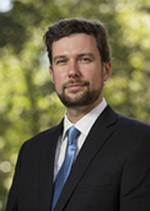 Alexander X. Gray |
Alexander X. Gray, assistant professor of physics at Temple University will present the next Physics Colloquium about "New Ways of Probing Materials and Interfaces with X-rays" from 4-5 p.m. Friday, Feb. 19, in the Paul Sharrah Lecture Hall, PHYS 133.
Abstract:
In this talk I will describe several new directions in the fields of X-ray spectroscopy and imaging, made possible with the advent of third-generation synchrotron light sources and free-electron lasers (FEL), and enabling investigations of fundamental physical processes in novel complex materials and technologically-relevant nanostructures and interfaces with depth- and time resolution. I will present the first results of hard X-ray angle-resolved photoemission measurements (HARPES) at excitation energies of up to 6 keV [1,2]. Compared to the traditional ARPES, carried out in the UPS regime (20-100 eV), this new technique enables one to probe up to 40 times deeper below the surface, thus allowing for more bulk-sensitive momentum-resolved electronic structure determination. Furthermore, I will introduce a new X-ray photoemission technique (SWARPES), which combines soft X-ray ARPES with standing-wave (SW) excited photoelectron spectroscopy, wherein the intensity profile of the exciting x-ray radiation is tailored within the sample in order to provide a depth-selective probe of the electronic structure of buried layers and interfaces [3,4]. Finally, I will discuss the latest state-of-the-art time-resolved THz-pump X-ray probe techniques, made possible by the unsurpassed brilliance and unique pulse structure of free-electron lasers, and enabling ultrafast control of electronic interactions in strongly correlated oxides with electric fields [5].
Gray received his doctorate in physics from the University of California Davis and the Lawrence Berkeley National laboratory, working with Chuck Fadley at the Advanced Light Source. He then received a postdoctoral fellowship at Stanford University where he remained for three years, carrying out his research at the SLAC National Accelerator Laboratory and the Linac Coherent Light Source with Joachim Stöhr and Hermann Dürr. He has been an assistant professor of physics at Temple University since 2014, and was just awarded with the Young Investigator Program Award by the U.S. Army Research Office.
Contacts
Paula Prescott, administrative specialist II
Department of Physics
479-575-2506, prescott@uark.edu